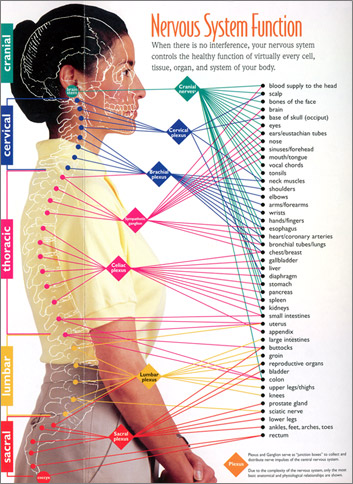Subluxation and the Chiropractic Lifestyle

Vertebral
Ver . te . bral - Concerning the vertebral bones of the spine.
Subluxation
Sub . lux . a . tion - Less than a complete dislocation of a joint with nervous system interference.
Complex
Com . plex - More than one part.
Nervous System Function
When there is no interference, your nervous system controls the healthy function of virtually every cell, tissue, organ, and system of your body.
Click here to view a larger image of the Nervous System Function illustration, located to the left.
A subluxation, or the Vertebral Subluxation Complex, is a serious condition identified by
its five parts:
Abnormal motion or position of spinal bones:
(Spinal Kinesiopathology) The bones of the spine have lost their normal motion and position. This can restrict your ability to turn and bend. It sets in motion the other four components.
Abnormal nervous system function:
(Neuropathophysiology) Improper spinal function can choke, stretch, or irritate delicate nerve tissue. The resulting nervous system dysfunction can cause symptoms elsewhere in the body.
Abnormal muscle function:
(Myopathology) Muscles supporting the spine can weaken, atrophy, or become tight and go into spasm. The resulting scar tissue can change muscle tone, requiring repeated spinal adjustments.
Abnormal soft tissue function:
(Histopathology) A rise in temperature from an increase in blood or lymph supply can result in swelling and inflammation. Discs can bulge, herniate, tear, or degenerate. Other soft tissues may suffer permanent damage.
Abnormal function of the spine and body:
(Pathophysiology) Bone spurs and other abnormal bony growths attempt to fuse malfunctioning spinal joints. This spinal decay, scar tissue, and long-term nerve dysfunction can cause other systems of the body to fail.
Like dominoes that fall in a chain reaction, problems that are left uncorrected can cause other parts of your body to not work as intended.
Whats the cause?
A subluxation, or more precisely, the Vertebral Subluxation Complex, describes what happens when spinal bones lose their normal motion or position from stress, trauma or chemical imbalances.
Automobile collisions, improper lifting, drugs, alcohol, emotional stress, chemical imbalances, and long periods of sitting can all cause the Vertebral Subluxation Complex.
Instead of just treating your symptoms, your chiropractor is primarily interested in detecting, reducing, and correcting the Vertebral Subluxation Complex.
THE CHIROPRACTIC LIFESTYLE
Chiropractors are experts in the care of the bones, nerves, muscles and connective tissues that make up about 60% of your body. All of the joints in your body are part of this musculo-skeletal system and its optimal function is necessary for overall good health. Ask your Doctor of Chiropractic for more information about a care program that may include specific spinal adjustments, exercise recommendations, nutritional advice or other conservative methods of care based on your health history, age, current condition and lifestyle.
REFERENCES:
Calliet, R., M.D., Soft Tissue Pain and Disability, F.A. Davis Company, 1977.
Calliet, R., M.D., Neck and Arm Pain, F.A. Davis Company, 1977.
Dvorak and Dvorak, M.D.s, Manual Medicine, Thieme-Stratton, 1984.
Ehni, G., M.D., Cervical Arthrosis, Yearbook Medical Publishers, Inc., 1984.
Gray, H., Grays Anatomy; Anatomy of the Human Body, 30th edition, Lea and Febiger, edited by Charles Mayo Gross, M.D., Philadelphia, 1989.
Haldeman, S., D.C., M.D., Modern Development in the Principles and Practice of Chiropractic, Appleton-Century-Crofts, 1980.
Kirkaldy-Willis, W., M.D., Managing Low Back Pain, 3rd edition, Churchill Livingstone, 1993.
Korr, I. M., M.D., The Collective Papers of Irvin M. Korr, American Academy of Osteopathy, 1979.
Roy, S., M.D., Irwin, R., M.D., Sports Medicine: Prevent, Evaluate, Management and Rehabilitation, Prentice-Hall, Inc., 1983.
Schafer, R., D.C., Faye, L., D.C., Motion Palpation and Chiropractic Technique, 2nd edition, Motion Palpation Institute, 1990.
Travell, J., M.D., Myofascial Pain and Dysfunction, Williams and Wilkins, 1983.
Walton, L., M.D., Essentials of Neurology, 6th edition, W.B. Saunders, 1989.
©2002 Back Talk Systems, Inc.
(800) 937-3113 (303) 277-9990
www.backtalksystems.com
(800) 937-3113 (303) 277-9990
www.backtalksystems.com
